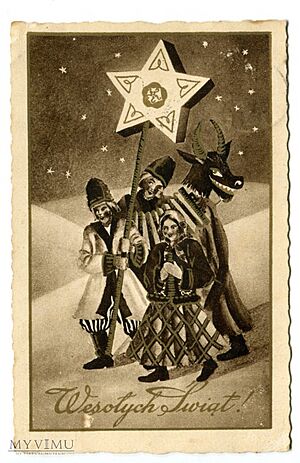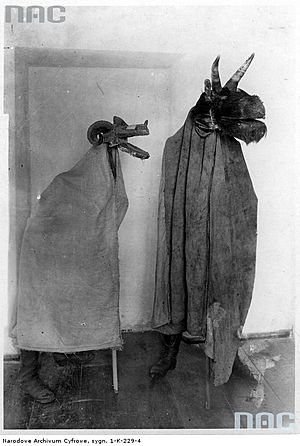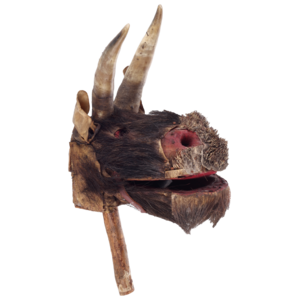Turoń facts for kids

In Polish folklore, Turoń is a fun and mysterious creature. It looks like a shaggy, black animal with horns and a big, floppy jaw. You can often see Turoń at special folk events. These events usually happen after Christmas, especially during Carnival time, which is before the period called Lent. The name "Turoń" comes from the old Polish word tur, which means "aurochs". An aurochs was a very large, wild ox that used to live in Europe.
Contents
How Turoń is Performed
The person playing Turoń wears a cloth sheet or a sheepskin. They hold a wooden pole in front of them. On top of the pole is a bull's head. This head has a floppy jaw and horns, sometimes real ones from a cow, or wooden ones. The head is often covered with rabbit fur or other animal skin.
The Turoń walks bent over or is led on a rope.
Turoń's Playful Antics
When a group of carolers enters a house, Turoń jumps around. It dances and makes sounds like a donkey. Turoń especially likes to play tricks on women. It might chase them around the house or playfully poke them with its jaw. While the carolers sing, Turoń claps its jaw to the song's beat. It also rings a bell that is on its neck.
The Turoń's muzzle, or snout, is made of thin wood. It is covered with rabbit skin and is big enough to "swallow" an apple. The person playing Turoń holds two sticks. They use these sticks to hit the floor with each step. Turoń might even jump over the sticks or over stools in the house.
The Turoń's "Fainting" Trick
At one point during the caroling, Turoń pretends to faint. Everyone then tries to "wake it up." They might give it a massage or light some hay like incense. They might also blow air under its "tail" or pour a special liquid into its muzzle. They even try to "undo hexes" or bad spells. After all this, Turoń "recovers" and starts to play again. This often signals that the visit is ending.
Regional Turoń Customs
The way Turoń looks and acts can be different in various parts of Poland. In Kraków, Turoń joins carolers who carry a star. This happens during the Epiphany holiday on January 6th. Turoń follows the carolers. When they enter a home, Turoń might playfully bump anyone who stares too long at the star or the people carrying it.
In Kielce County, people walk around the village with an aurochs, also called a "turuń." This happens during the last week of Carnival. A similar tradition is found in Tarnów. There, Turoń is joined by other characters like a Tatar (a Turkish man) and a Żyd (a Jew). In Mielec, people walk with Turoń on Christmas Eve.
Saying Goodbye to Turoń
Sometimes, Turoń might become a bit too much for the family in the house. When this happens, they sing a special song to make it leave:
Idź, turoniu, do domu
nie zawadzaj nikomu
nie tuś się wychował
nie tu będziesz nocował
This song roughly means:
Go now, Turoń, go home
Don't you bother any more souls
Here's not the place you live
This not the place you shall sleep
After the song, the homeowner gives the carolers a "farewell gift." This is usually money and a treat from their pantry. The carolers thank them for the gifts and then move on to the next house.
Where Does the Name Turoń Come From?
The name Turoń comes from the word tur, which means "aurochs". An aurochs was a large, wild ox that lived a long time ago. Some old beliefs connect the aurochs to the sun. It was seen as a symbol of the sun's power. Because Turoń appears around Christmas, when the days start to get longer and the sun returns, it might be linked to these old ideas about the sun and new beginnings.
What Turoń Represents
Turoń is a symbol of good luck and new growth. It is a way of wishing good things for the householders. When Turoń playfully pokes people with its horns, it's like it's passing on good fortune. This includes wishes for healthy crops, strong animals, and a happy family.
See also
- Krampus – a related figure in Central European folklore



